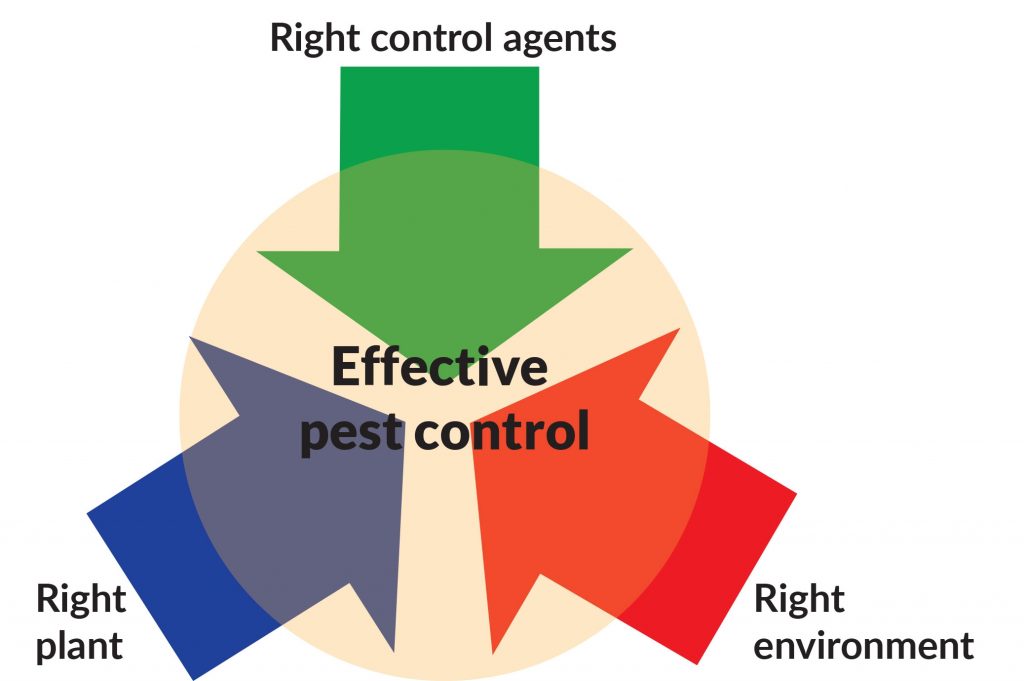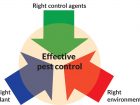
Features
Biocontrols
Inputs
Designing Your Greenhouse IPM Program
There are many interactive variables that affect the growth of greenhouse crops, the incidence and impact of pests and diseases, and the performance of biological and chemical controls.
April 11, 2017 By Drs. Rose Buitenhuis and Michael Brownbridge
 The ‘Systems Approach’: Utilizing different elements in plant production that collectively enable successful pest and disease control – plant, environment and control agents.
The ‘Systems Approach’: Utilizing different elements in plant production that collectively enable successful pest and disease control – plant, environment and control agents. May 2017 – In this six-part series of articles on thrips integrated pest management, we will provide practical application tips and tricks, information on new technologies and how it all fits within an overall IPM program. Each article will be accompanied by a short video demonstrating a technique or principle.
The content of this series is based on research performed at Vineland Research and Innovation Centre and is supplemented with ‘information from the field,’ contributed by colleagues using biocontrol strategies in greenhouse production. For more information on specific biocontrol agents or IPM in general, see www.greenhouseIPM.org.
PART 1. A CHECKLIST
The effective use of biologicals (bios) requires a different approach and philosophy than for chemicals. Biological control agents are better at preventing than curing pest and disease problems.
Use of tools such as ‘action thresholds,’ which guide the timing of pesticide sprays when pest populations reach a certain level, don’t work for biocontrol. Why? Because if you wait until these thresholds are reached before initiating a biocontrol strategy, it’ll be too late; pest populations will be too large to be brought under control using a biological agent.
The efficient use of biocontrols requires different assumptions and timing of actions. In addition, rarely does one biological serve as a ‘stand-alone’ control agent; rather, they need to be deployed within a system that supports their success. This first article highlights key aspects of a pest management system and future content that will provide more detailed insights to the use of biocontrol, in particular for thrips.
THE SYSTEMS APPROACH
There are many interactive variables that affect the growth of greenhouse crops, the incidence and impact of pests and diseases, and the performance of biological and chemical controls. These include:
- the type of crop and crop growth stage.
- production practices and inputs.
- external environmental conditions (temperature, humidity, light).
Different pests (and diseases) can be problematic at different stages of crop development, and at different times of year. Understanding of the effects these factors have on the plant, pests and their control agents, is essential to the production of a healthy crop, and successful management of pests and diseases. Since biological control agents are living organisms, they are directly affected by all of these changing factors. It is critical for a successful IPM program to understand how these organisms function efficiently and the issues that can impede their activity.
IPM FROM START TO FINISH
It is important to prevent insect and disease pressure from the very beginning of crop production. The best pest management plans start before young plants come into the greenhouse and are adapted to the different crop production stages. While an IPM program must be conceived and implemented for the entire production cycle, different approaches may be considered for different phases in the crop cycle.
Preparation: “Think before you act.” Take a critical look at the plant species and cultivars you are planning to grow, your fertilizer, irrigation schedules and general layout of the greenhouse. This will help identify potential problems. Part 2 of this series will go into more details, but here are some thoughts to keep in mind:
- What do you know about the plants you will be growing?
Are they attractive to pests? Are they susceptible to damage? If possible, select pest-resistant cultivars. If not, then use pest-susceptible cultivars as indicator plants for early warning in your scouting program and also group more easily damaged varieties together as a focus for your biocontrol releases.
- What do fertilizer and irrigation have to do with pest problems?
For certain crops, there is a direct link between the fertilizer rate and infestation by pests like thrips and aphids.
Although most greenhouse crops are on high-fertilizer regimes, not all plant species require these elevated rates. Research suggests that in some crops, fertilizers can be reduced by 33 to 75 per cent without affecting the quality of the finished plants, and reducing their susceptibility to pests.
As well, plants that are over-watered or water-stressed are more susceptible to pests. More research is needed to provide recommendations on balancing plant growth and pest resistance.
- Based on previous years, where are the trouble spots in your greenhouse operation?
Design the greenhouse layout so that (supposedly) clean plant material is kept separate from plants that are more likely to be infested.
Propagation: “Begin as you mean to go on.” Part 2 of this series will address the principle of starting clean. This is one of the basics of an IPM program and propagation is the ideal place to nip pest problems in the bud.
- How clean are your cuttings or plugs?
Pests travel the world on plant material, including propagative cuttings. Even if you are producing your own cuttings, you may be recycling your pest problems. Cutting dips can help reduce pest populations on propagative material and buy valuable time for bios to establish.
- Front-loading of bios: Propagation is the time to build up your ‘army’ of biocontrol agents.
Since plants are close to each other, only a small amount of product is needed to cover all plants. Some biocontrol agents, such as Dalotia (=Atheta) and soil predatory mites, will establish without the need for further releases, others will have to be released on a regular basis throughout the production cycle.
- At this stage, thrips biocontrol programs rely on predatory mites and biopesticides such as BotaniGard and Met52.
The performance of these biocontrol agents depends on how and where you apply them. Parts 3 and 4 of this series will be dedicated to this subject.
Production: When the plants are moved out of propagation into the production area, it is time to think about how pests get into this area of the greenhouse and how to continue the biocontrol program initiated during propagation, tweaking it where necessary. Needless to say, scouting is essential to determine if your strategy is working and to detect any unexpected visitors.
- Screening (see Part 2 of this series) and mass trapping (see Part 5 of this series) are two ways to deal with pests coming in from outside.
- For thrips biocontrol in production, predatory mites are still the best agents.
However, due to differences in plant spacing and environmental conditions, what worked in propagation may not perform as well in the production area. Part 4 of this series will address these differences and provide information on the choice of predatory mite species and formulation (e.g. bulk product vs. breeding sachets), and use of supplemental food. Biopesticides can still play a role (see Part 3 of this series). The predator Orius insidiosus may also be a good addition to the program, with or without banker plants (see Part 5 of the series).
- Inevitably, at some point during production, you will have to deal with a pest outbreak.
A few things should be checked while there is still time to adjust your IPM program. Remember that biocontrol agents can’t perform miracles, and that patience is required. Also, make sure to use the correct biocontrol agent for your outbreak through proper pest identification. Finally, it is important to check the quality of incoming biocontrol agents (see http://www.vinelandresearch.com/sites/default/files/grower_guide_final_version.pdf) and to monitor their performance in the greenhouse.
- In some cases, one or more applications of pesticides are needed to bring pest levels down to a manageable level for bios, or to control a pest that can’t be controlled biologically.
Part 6 of this series will address the importance of choosing the pesticide that is most compatible with your biocontrol program and to consider targeted spot sprays.
Finishing: What to do when you are close to shipping and you still have too many pests in your crop? Luckily, there are a few rescue options:
- If you still have a few weeks left before shipping, it may be worth increasing the release of biocontrol agents, or to add a different biocontrol agent to the mix.
Another option is to increase mass trapping. Every pest caught on a trap is one less on your crop. Again, you may not obtain instant results, but it may be just enough to tip the balance in your favour.
- Another common practice is to do one or two “clean-up sprays” of pesticides.
At this point in the production cycle, it is not as important anymore to ensure a compatibility with the biocontrol program, so there is a greater choice of products. An added bonus of maintaining a biocontrol program as long as possible, is that pests in the greenhouse have not been exposed to repeated applications of the same pesticides and are less likely to become resistant. More about this in Part 6 of this series.
Evaluation: When the last plant is shipped and the greenhouse is cleaned, it is time to evaluate the efficacy of the IPM program. Are you happy with the results? What worked and what didn’t? What needs improving? And most importantly: how much did it cost? This is one of the reasons why keeping records is so essential. You will be able to compare crops over multiple years and to decide where to invest your biocontrol budget for maximum results.
We hope you are looking forward to the next articles in this series. We always appreciate feedback, so if you have any suggestions for topics, or comments, please let us know (Rose.Buitenhuis@vinelandresearch.com; Michael.Brownbridge@vinelandresearch.com).
Print this page

